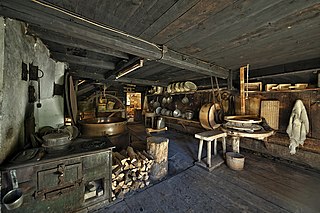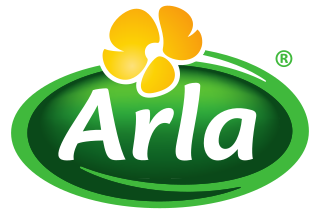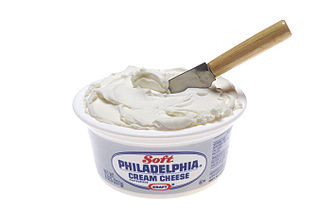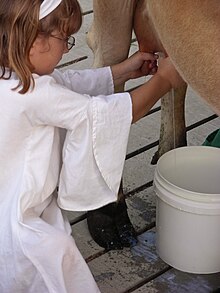
Edward Jenner was an English physician and scientist who pioneered the concept of vaccines and created the smallpox vaccine, the world's first vaccine. The terms vaccine and vaccination are derived from Variolae vaccinae, the term devised by Jenner to denote cowpox. He used it in 1798 in the title of his Inquiry into the Variolae vaccinae known as the Cow Pox, in which he described the protective effect of cowpox against smallpox.

Mozzarella is a semi-soft non-aged cheese prepared by the pasta filata ('stretched-curd') method with origins from southern Italy.

Cowpox is an infectious disease caused by the cowpox virus (CPXV). It presents with large blisters in the skin, a fever and swollen glands, historically typically following contact with an infected cow, though in the last several decades more often from infected cats. The hands and face are most frequently affected and the spots are generally very painful.

A dairy is a place where milk is stored and where butter, cheese and other dairy products are made, or a place where those products are sold. It may be a room, a building or a larger establishment. In the United States, the word may also describe a dairy farm or the part of a mixed farm dedicated to milk for human consumption, whether from cows, buffaloes, goats, yaks, sheep, horses or camels.

Halloumi or haloumi is a cheese of Cypriot origin made from a mixture of goat's and sheep's milk, and sometimes also cow's milk. Its texture is described as squeaky. It has a high melting point and so can easily be fried or grilled, a property that makes it a popular meat substitute. Rennet is used to curdle the milk in halloumi production, although no acid-producing bacteria are used in its preparation.

Monterey Jack, sometimes shortened to Jack, is a Californian white, semi-hard cheese made using cow's milk, with a mild flavor and slight sweetness. It has been called "an American original" and "as a vestige of Spanish rule in the early nineteenth century, derives from a Franciscan monastic style of farmer's cheese."

Arla Foods is a Danish-Swedish multinational cooperative based in Viby, Denmark. It is the fifth biggest dairy company in the world and the largest producer of dairy products in Scandinavia and United Kingdom.

Condensed milk is cow's milk from which water has been removed. It is most often found with sugar added, in the form of sweetened condensed milk, to the extent that the terms "condensed milk" and "sweetened condensed milk" are often used interchangeably today. Sweetened condensed milk is a very thick, sweet product, which when canned can last for years without refrigeration if not opened. The product is used in numerous dessert dishes in many countries.

Macaroni and cheese is a dish of macaroni and a cheese sauce, most commonly cheddar sauce.

Cream cheese is a soft, usually mild-tasting fresh cheese made from milk and cream. Cream cheese is not naturally matured and is meant to be consumed fresh, so it differs from other soft cheeses such as Brie and Neufchâtel. It is more comparable in taste, texture, and production methods to Boursin and mascarpone. Stabilizers such as carob bean gum and carrageenan are often added in industrial production.

Milk delivery is a delivery service dedicated to supplying milk, typically in bottles or cartons, to customers' homes. This service is performed by a milkman, milkwoman, or milk deliverer. The delivery route is a milk route or milk run.

"Sing a Song of Sixpence" is an English nursery rhyme, perhaps originating in the 18th century. It is listed in the Roud Folk Song Index as number 13191. The sixpence in the rhyme is a British coin that was first minted in 1551.
"The Farmer in the Dell" is a singing game, nursery rhyme, folksong, and children's song. It probably originated in Germany and was brought to America by immigrants. From there, it spread to many other nations and is popular in a number of languages. It is Roud Folk Song Index number 6306.

Kashk, qurut, chortan, or aaruul and khuruud is a range of dairy products popular in Middle Eastern cuisine, Caucasian cuisine, and Central Asian cuisine. Kashk is made from strained yogurt, drained buttermilk or drained sour milk by shaping it and letting it dry. It can be made in a variety of forms, like rolled into balls, sliced into strips, and formed into chunks.

The Milkmaid, sometimes called The Kitchen Maid, is an oil-on-canvas painting of a "milkmaid", in fact, a domestic kitchen maid, by the Dutch artist Johannes Vermeer. It is in the Rijksmuseum in Amsterdam, the Netherlands, which regards it as "unquestionably one of the museum's finest attractions".

Strained yogurt, Greek yogurt, yogurt cheese, sack yogurt or kerned yogurt is yogurt that has been strained to remove most of its whey, resulting in a thicker consistency than normal unstrained yogurt, while still preserving the distinctive sour taste of yogurt. Like many types, strained yogurt is often made from milk enriched by boiling off some water content, or by adding extra butterfat and powdered milk. In Europe and North America, it is often made from low-fat or fat-free cow's milk. In Iceland, a similar product named skyr is made.

Cheese is a dairy product produced in a range of flavors, textures, and forms by coagulation of the milk protein casein. It comprises proteins and fat from milk. During production, milk is usually acidified and either the enzymes of rennet or bacterial enzymes with similar activity are added to cause the casein to coagulate. The solid curds are then separated from the liquid whey and pressed into finished cheese. Some cheeses have aromatic molds on the rind, the outer layer, or throughout.

The Milkmaid and Her Pail is a folktale of Aarne-Thompson-Uther type 1430 about interrupted daydreams of wealth and fame. Ancient tales of this type exist in the East but Western variants are not found before the Middle Ages. It was only in the 18th century that the story about the daydreaming milkmaid began to be attributed to Aesop, although it was included in none of the main collections and does not appear in the Perry Index. In more recent times, the fable has been variously treated by artists and set by musicians.




















